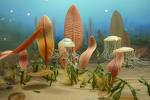 |
 |
 |
 |
 |
Produced
by the Population Genetics and Evolution class, Furman University |
||||
 |
 |
 |
 |
 |
Produced
by the Population Genetics and Evolution class, Furman University |
||||
 |
The
Ediacaran: Kimberella |
 |
Kimberella
quadrata was roughly oval-shaped and bilaterally
symmetrical. Their fossils range from approximately 3 to 105 mm in length
(Fedonkin and Waggoner 1997). They are classified under Vendozoa among
other animals that lived before the Cambrian explosion (Fossil Museum).
Kimberella was originally found in southern Australia in the
Ediacara Hills. More recently, numerous specimens have been found in
the Winter Coast of the White Sea of northern Russia. These fossils
date back to approximately 555 million years ago (Palaeos). The classification
of Kimberella has been a topic of debate since it was first
discovered. Some argue that it should be classified as a mollusc because
it is more complex than a flatworm and has certain features that resemble
the shell and foot of a mollusc. Assuming this view is correct, Kimberella
is important because it provides proof that diverse, triploblastic,
metazoan animal lineages existed before the Cambrian (Fedonkin and Waggoner
1997). Page by Laura Snyder |
 |
| Kimberella quadrata. Photo Credit: The Fossil Museum. | |
| Fedonkin
MA, Waggoner BM. 1997. The Late Precambrian fossil Kimberella is a
mollusc-like bilaterian organism. Nature. 388: 868-871.
Fossil Museum. 2008. Unusual vendian protomollusc Kimberella. Accessed Jan. 25, 2010. Clowes, C. 2002. The ediacaran - 2. www.Paleos.com. Accessed January 25, 2010. |